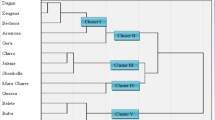Abstract
Fifty-one potato cultivars were evaluated for reaction to infection byPseudomonas solanacearum Sm. under high disease pressure in a field plot near Tifton, Georgia during the spring of 1978 and 1979. Plots were infested by clipping beds of thickly seeded tomato plants with a rotary mower contaminated with the wilt baterium in 1975, 1976, 1977 and 1978. The plants were incorporated into the soil following disease development. In addition to the use of infested soil, one stem on each potato plant was inoculated in late May by cutting with a knife blade dipped in a bacterial suspension. Most of the cultivars evaluated were highly susceptible to bacterial wilt. Ontario was the only cultivar highly resistant to the disease, with only 1% and 8% dead or dying plants in 1978 and 1979, respectively. Based on tuber infection, Ontario and Snowchip were the most resistant, with 9% and 14% infection, respectively, in 1978 and both 4% in 1979. Saco, Green Mountain and Sebago also showed some resistance.
Resumen
Se evaluaron para su reacción a infección porPseudomonas solanacearum Sm. 51 cultivares de papa bajo presión alta de la enfermedad en una parcela de campo cerca de Tifton, Georgia durante la primavera de 1978 y 1979. La infestación de la parcela fué realizada cegando camas de tomate densamente sembrado con una cegadora de césped rotativa contaminada con la bacteria en 1975, 1976, 1977 y 1978. Después del desarrollo de la enfermedad se incorporaron las plantas al suelo. Además de usar suelo infestado, se inoculó un tallo de cada planta de papa a fines de Mayo con una cuchilla sumergida en una suspensión de la bacteria. La mayoría de los cultivares fureon altamente susceptibles a la marchitez bacteriana. El único cultivar altamente resistente fué Ontario, con sólo 1% y 8% plantas muertas o moribundas en 1978 y 1979, respectivamente. En base a infección de tubérculos, Ontario y Snowchip fueron las mas resistentes con 9% y 14% de infección, respectivamente en 1978 y ambos con 4% en 1979. Los cultivares Saco, Green Mountain y Sebago también mostraron cierta resistencia.
Similar content being viewed by others
Literature Cited
Boesewinkel, H. J. 1976. Mottery-eye still threatens potato crops. N Z J Agr (January issue): 21–22.
Eddins, A. H. 1936. Brown rot of Irish potatoes and its control. Univ Fla Tech Bull 299. 44 p.
Enfinger, J. M., S. M. McCarter and C. A. Jaworski 1979. Evaluation of selected chemicals and methods of application for control of bacterial wilt of tomato transplants. Phytopathology 69:637–640.
Kelman, A. 1953. The bacterial wilt caused byPseudomonas solanacearum. North Carolina Agric Exp Stn Tech Bull 99. 194 p.
Lloyd, A. B. 1975. Grower attitudes to bacterial wilt of potatoes. J Aust Inst Agric Sci 41:215–216.
McCarter, S. M. and C. A. Jaworski 1969. Field studies on spread ofPseudomonas solanacearum and tobacco mosaic virus in tomato plants by clipping. Plant Dis Rep 53:942–946.
McCarter, S. M. 1973. A procedure for infesting field soils withPseudomonas solanacearum. Phytopathology 63:799–800.
McCarter, S. M. 1976. Persistence ofPseudomonas solanacearum in artificially infested soils. Phytopathology 66:998–1000.
McCarter, S. M., P. D. Dukes and C. A. Jaworski. 1969. Vertical distribution ofPseudomonas solanacearum in several soils. Phytopathology 59:1675–1677.
Olsson, K. 1976. Experience of brown rot caused byPseudomonas solanacearum Sm. in Sweden. EPPO (European Meditern Plant Prot Organ) Bull 6:199–207.
Robinson, R. A. July, 1968. The concept of vertical and horizontal resistance as illustrated by bacterial wilt of potato. Commonwealth Mycological Institute, Kew, Surrey, England. Phytopathological Papers, No. 10. 37 p.
Sequeira, Luis and P. R. Rowe 1969. Selection and utilization ofSolanum phureja clones with high resistance to different strains ofPseudomonas solanacearum. Am Potato J 46:451–462.
Thurston, H. David. 1963. Bacterial wilt of potatoes in Columbia. Am Potato J 40:381–390.
Author information
Authors and Affiliations
Additional information
Supported by State, Hatch and USDA funds allocated to the Georgia Agricultural Experiment Stations and Southern Region-Science and Education Administration.
Rights and permissions
About this article
Cite this article
Jaworski, C.A., Webb, R.E., Goth, R.W. et al. Relative resistance of potato cultivars to bacterial wilt. American Potato Journal 57, 159–165 (1980). https://doi.org/10.1007/BF02853867
Received:
Issue Date:
DOI: https://doi.org/10.1007/BF02853867




